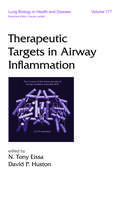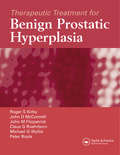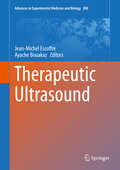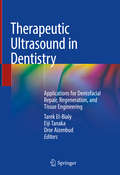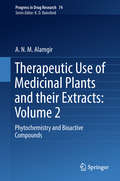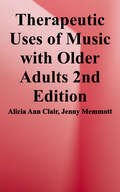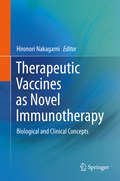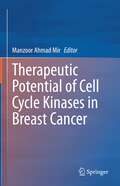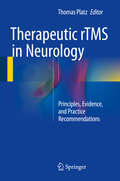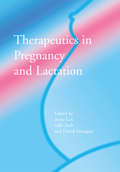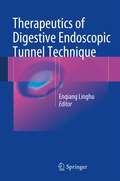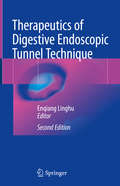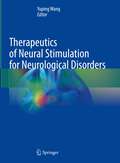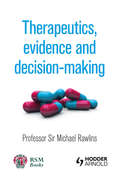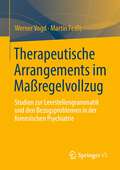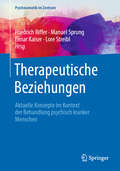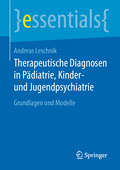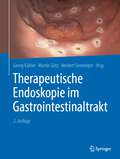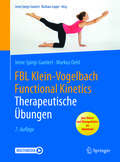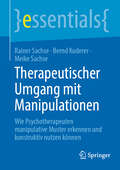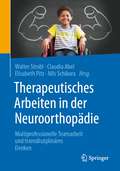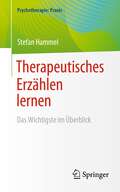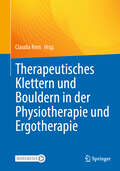- Table View
- List View
Therapeutic Targets in Airway Inflammation (Lung Biology in Health and Disease)
by N. Tony Eissa David P. HustonThis reference examines the cellular, molecular, and genetic mechanisms involved in airway inflammation, as well as the pathophysiology, epidemiology, and aetiology of asthma. It explores strategies to prevent cellular injury and oxidative tissue damage, inhibit key inflammatory pathways and identify disease-specific targets to reduce the induction
Therapeutic Treatment for Benign Prostatic Hyperplasia
by Peter Boyle Roger S Kirby John D McConnell John M Fitzpatrick Claus G Roehrborn Michael G WyllieThe spectrum of available treatment options for benign prostatic hyperplasia (BPH) is matched by the spectrum of disease severity, and with up to 90% of men in their 80s suffering from BPH to some extent, it is imperative that patients are offered the full range of options to manage the disease. Pharmacologic therapies available for the treatment o
Therapeutic Ultrasound
by Jean-Michel Escoffre Ayache BouakazThis book highlights advances and prospects of a highly versatile and dynamic research field: Therapeutic ultrasound. Leading experts in the field describe a wide range of topics related to the development of therapeutic ultrasound (i. e. , high intensity focused ultrasound, microbubble-assisted ultrasound drug delivery, low intensity pulsed ultrasound, ultrasound-sensitive nanocarriers), ranging from the biophysical concepts (i. e. , tissue ablation, drug and gene delivery, neuromodulation) to therapeutic applications (i. e. , chemotherapy, sonodynamic therapy, sonothrombolysis, immunotherapy, lithotripsy, vaccination). This book is an indispensable source of information for students, researchers and clinicians dealing with non-invasive image-guided ultrasound-based therapeutic interventions in the fields of oncology, neurology, cardiology and nephrology.
Therapeutic Ultrasound in Dentistry: Applications for Dentofacial Repair, Regeneration, and Tissue Engineering
by Tarek El-Bialy Eiji Tanaka Dror AizenbudThis book highlights the potential of low-intensity pulsed ultrasound, or LIPUS, to introduce a new era in dentistry by revolutionizing the approach to dental treatment and providing a cure for pathologic conditions long considered untreatable. Readers will find information on all aspects of LIPUS, from its mode of action and biologic mechanisms to the full range of emerging clinical applications. The role of LIPUS in promoting dental tissue repair and regeneration and in tissue engineering is fully explained in a series of chapters focusing on stimulation of cell metabolism in the dentocraniofacial region, bone healing, periodontal regeneration, the temporomandibular joint, pulp cell differentiation, the salivary glands, and orthodontics. The past two decades have witnessed numerous discoveries that have enhanced the scope for use of therapeutic ultrasound in dentistry. In summarizing the latest knowledge in this exciting field, the book will be of interest to dental surgeons, orthodontists, periodontists, and other practitioners.
Therapeutic Use of Medicinal Plants and their Extracts: Phytochemistry and Bioactive Compounds (Progress in Drug Research #74)
by A.N.M. AlamgirThis book starts with a general introduction to phytochemistry, followed by chapters on plant constituents, their origins and chemistry, but also discussing animal-, microorganism- and mineral-based drugs. Further chapters cover vitamins, food additives and excipients as well as xenobiotics and poisons. The book also explores the herbal approach to disease management and molecular pharmacognosy and introduces methods of qualitative and quantitative analysis of plant constituents.Phytochemicals are classified as primary (e.g. carbohydrates, lipids, amino acid derivations, etc.) or secondary (e.g. alkaloids, terpenes and terpenoids, phenolic compounds, glycosides, etc.) metabolites according to their metabolic route of origin, chemical structure and function. A wide variety of primary and secondary phytochemicals are present in medicinal plants, some of which are active phytomedicines and some of which are pharmaceutical excipients.
Therapeutic Uses of Cannabis
by British Medical AssociationAt the last Annual Representative Meeting of the British Medical Association a motion was passed that `certain additional cannabinoids should be legalized for wider medicinal use.'' This report supports this landmark statement by reviewing the scientific evidence for the therapeutic use of cannabinoids and sets the agenda for change. It will be welcomed by those who believe that cannabinoids can be used in medical treatment. The report discusses in a clear and readable form the use and adverse effects of the drug for nausea, multiple sclerosis, pain, epilepsy, glaucoma, and asthma.
Therapeutic Uses of Music with Older Adults
by Alicia Clair Jenny MemmottIn this comprehensively updated second edition, written by Alicia Ann Clair and Jenny Memmott the extraordinary benefits of music therapy for older adults are detailed. <p><p>Therapeutic Uses of Music with Older Adults not only examines these benefits but also clarifies the reasons that music is beneficial. This important book shows both informal and formal caregivers how to use music to enhance the quality of life of older adults - including people with physical impairments and people with dementia. <p><p>Written by two of the nation's leading music therapists, Therapeutic Uses of Music with Older Adults offers strategies for using music to: provide diversion for inactivity, discomfort, and daily routine; decrease symptoms of depression, anxiety insomnia, and agitation; handle problem behaviors; provide physical and emotional stimulation; help in the rehabilitation of people with cardiac disease, Parkinson's disease, and impairments related to stroke; help in the management of pain; facilitate social integration; communication; and the expression of feelings, including anger and grief; and relieve the stress and tension associated with caring for older adults.
Therapeutic Vaccines as Novel Immunotherapy: Biological and Clinical Concepts
by Hironori NakagamiThis book offers an excellent introduction to the use of novel therapeutic vaccines for common diseases based on their ability to induce antibody production. While the role of vaccines in the treatment of infectious diseases and cancer is well known, vaccines have also recently been developed for a variety of other conditions, including Alzheimer’s disease, hypertension, diabetes, and spondyloarthritis. These therapeutic advances are fully and clearly documented by acknowledged experts in the field, who explain the relevant biology and highlight the challenges involved in deploying this treatment approach effectively and safely. In addition, recent progress in the construction and delivery of DNA vaccines is documented, and the process of developing new peptide vaccines is explored in depth. While the book will be particularly valuable for researchers and scholars interested in immunotherapy, it will also appeal to clinicians seeking effective new medicines to treat patients suffering from chronic diseases.
Therapeutic potential of Cell Cycle Kinases in Breast Cancer
by Manzoor Ahmad MirThis book highlights the interrelation between cell cycle regulators and breast cancer phenotypes. It reviews the roles of Cyclin-Dependent Kinases (CDK) in driving cell cycle progression, cell cycle checkpoints and dysregulation in breast cancer. It also examines the prognostic significance of CDKs in breast cancer. and CDK inhibitors for the treatment of metastatic breast cancer. Further, the book discusses the role of different G1 cyclins in differentiation, chromosome stability, and transcriptional regulation in breast cancer. Additionally, it examines the role of immunogenic effects of CDK inhibitors, the mechanism of resistance and the current clinical trials in breast cancer treatment. Towards the end, the book explores cell cycle regulation as an attractive target for targeted drug therapy in breast cancer. This book is a comprehensive yet concise resource for oncologists and researchers interested in exploring the therapeutic potential of Cyclin-Dependent Kinases in breast cancer.
Therapeutic rTMS in Neurology
by Thomas PlatzThis comprehensive reference on therapeutic repetitive transcranial magnetic stimulation (rTMS) documents the current status in the field. The main focus is the clinical applications of rTMS tested to date, including treatment of paresis, aphasia, and visual neglect in stroke patients, therapy for motor impairment in Parkinson's disease, and applications for tinnitus and neuropathic pain. Based on the available clinical evidence (RCTs, meta-analyses, and systematic reviews), combined with the personal experience of experts, a clinically oriented best evidence synthesis is provided for each application, together with a clear description of rTMS algorithms that generate clinical benefits in the target domain. A further feature is the presentation of a theoretical model of therapeutic action for each therapeutic target. The book will be invaluable for clinicians and researchers in neurology and related fields, including neurologists, physiatrists, as well as ENT and pain specialists.
Therapeutics in Pregnancy and Lactation
by Anne Lee Sally Inch David FineganThis book will assist doctors, pharmacists, midwives and other health professionals in dealing with the issue of medicine use in pregnant and breastfeeding women. It gives practical guidance on the principles of safe and effective prescribing, summarises the known effects of widely used drugs, and provides up-to-date information in one accessible source. With an impressive list of contributors, Therapeutics in Pregnancy and Lactation offers clear guidelines and comprehensive advice on a diverse range of topics from drug abuse to hypertension and epilepsy.
Therapeutics of Digestive Endoscopic Tunnel Technique
by Enqiang LinghuThis book elaborates on a whole new understanding of digestive endoscopy, the core of which is to treat quite a number of diseases using minimally invasive methods, provides the walls of the digestive tube are free of perforations. Currently, the tunnel technique has been applied in the treatment of digestive early stage carcinomas, esophageal achalasia and submucosal tumors originating from muscularis propria. And this promising technique would surely be more widely used in the future. The main contents of this book include the history of the digestive endoscopic tunnel technique, the practical anatomy involved, operation steps, indications and contraindications, complications and possible future exploration fields. This book is well suited for doctors and surgeons performing digestive endoscopic therapies.
Therapeutics of Digestive Endoscopic Tunnel Technique
by Enqiang LinghuThis book elaborates on a whole new understanding of digestive endoscopy, the core of which is to treat quite a number of diseases using minimally invasive methods. Currently, the tunnel technique has been applied in the treatment of digestive early stage carcinomas, esophageal achalasia and submucosal tumors originating from muscularis propria. And this promising technique would surely be more widely used in the future. The main contents of this book include the history of the digestive endoscopic tunnel technique, the practical anatomy involved, operation steps, indications and contraindications, complications and possible future exploration fields. This book is well suited for doctors and surgeons performing digestive endoscopic therapies.
Therapeutics of Neural Stimulation for Neurological Disorders
by Yuping WangThis book mainly focuses on diversity of brain diseases, such as sleep disorders, major depression disorder, anxiety disorders, epilepsy, cognitive disorders, etc. It introduces the current pathological mechanisms of various diseases from the perspective of basic theories and research; it introduces the clinical evaluation and treatment of the above diseases from the clinical perspective. In addition, the current frontier research on therapeutics of neural stimulation for the above brain disorder was introduced, such as Transcranial electrical stimulation, magnetic stimulation, ultrasonic stimulation, etc., and the therapeutic strategy and stimuli parameters for reference were proposed.This book is aimed at clinical students, doctors and researchers in the field of neurology. Based on major brain diseases, this book systematically proposed the maneuverability, safety and effectiveness of neural stimulation technologies in the treatment of major brain diseases.
Therapeutics, Evidence and Decision-Making
by Michael RawlinsThis book is intended to help decision-makers use, assess and appraise the evidence that underpins decisions about the use of therapeutic interventions. It will inform decision-makers about the nature of evidence, the strengths and weaknesses of the available approaches, and how these can be most effectively distilled for the purpose of reaching re
Therapeutische Arrangements im Maßregelvollzug: Studien zur Leerstellengrammatik und den Bezugsproblemen in der forensischen Psychiatrie
by Werner Vogd Martin FeißtAuf Basis von Feldforschungen und Interviews in 6 forensischen Kliniken werden die Herausforderungen der Therapie und Resozialisierung im Maßregelvollzug untersucht. Es werden grundlegende Dilemmata der Therapie unter Zwang herausgearbeitet und typische Probleme und Chancen aufgezeigt, die mit Versuch der Normalisierung der Patienten einhergehen. Es wird eine systemische Analyseperspektive gewählt, die den Blick sowohl auf die konkreten Beziehungen wie auch das organisationale Gefüge und seiner gesellschaftlichen Einbettung lenkt.
Therapeutische Beziehung und die Behandlung chronischer Depressionen
by Valerija Sipos Philipp Klein Antje Demmert James P. Mccullough Jr. Ulrich SchweigerCBASP (Cognitive Behavioral Analysis System of Psychotherapy) hebt das Neutralitätsprinzip des Therapeuten auf Seit mehr als einem Jahrhundert wird die Rolle des Psychotherapeuten dominiert durch Freuds Neutralitätsregel: Ein Therapeut darf die Beziehung zu seinen Patienten nicht persönlich gestalten. James P. McCullough, Jr., hinterfragt dieses weit verbreitete Diktum mit seinem neuen Behandlungsansatz für chronische depressive Patienten: Er empfiehlt eine diszipliniert persönliche Gestaltung der therapeutischen Beziehung statt therapeutischer Neutralität. Die therapeutische Beziehung kann auf diese Weise konkret eingesetzt werden, um pathologische Verhaltensmuster chronisch depressiver Patienten zu verändern. Die neue methodische Gestaltung der persönlichen Therapiebeziehung mit chronisch depressiven Patienten In diesem Buch beschreibt James P. McCullough, Jr., detailliert und anhand zahlreicher einprägsamer Fallbeispiele, wie er eine diszipliniert persönliche Gestaltung der therapeutischen Beziehung definiert und wie sie angewendet wird. Seine psychotherapeutische Erfahrung gepaart mit seinem frischen Blick auf die therapeutische Beziehung machen das Buch zu einer spannenden Lektüre für alle praktizierenden Psychotherapeuten und Psychotherapieforscher. Übersetzt und bearbeitet von den Fachleuten der Methode im deutschsprachigen Raum
Therapeutische Beziehungen: Aktuelle Konzepte im Kontext der Behandlung psychisch kranker Menschen (Psychosomatik im Zentrum #4)
by Friedrich Riffer Elmar Kaiser Manuel Sprung Lore StreiblGute zwischenmenschliche Beziehungen sind von grundlegender Bedeutung für jede Form der therapeutischen Arbeit. Das vierte Buch in der Reihe Psychosomatik im Zentrum widmet sich den Ansprüchen und Realitäten, Chancen und Risiken der therapeutischen Arbeit mit psychisch kranken Menschen. Fritz Riffer eröffnet mit der wichtigen Frage, was die gute Therapeutin und ihre therapeutischen Beziehungen ausmacht. Weitere Beiträge beschäftigen sich mit realistischen Ansprüchen und Erwartungen an Therapeuten, Übertragungsphänomenen sowie Liebe und erotischem Erleben in therapeutischen Beziehungen. Anschließend werden Chancen von achtsamkeitsbasierten und systemischen Herangehensweisen sowie Filmtherapie und tiergestützter Entwicklungsförderung aufgezeigt. Mögliche Risiken, wie etwa Grenzüberschreitungen, Aggression und Gewalt sowie sekundäre Traumatisierung werden ebenso thematisiert.Dieses Buch richtet sich in erster Linie an Ärzte, Psychotherapeuten, Klinische- und Gesundheitspsychologen sowie verwandte Berufsgruppen, die therapeutische Beziehungen mit psychisch kranken Menschen gestalten.
Therapeutische Diagnosen in Pädiatrie, Kinder- und Jugendpsychiatrie: Grundlagen und Modelle (essentials)
by Andreas LeschnikIn Deutschland haben wir zwei Klassifikationsmodelle, um Kinder mit Problemen und Ressourcen ganzheitlich zu erfassen. Zum einen die ICD-10 (International Statistical Classification of Diseases and Related Health Problems 10. Revision) und zum anderen die ICF-CY (International Classification of Functioning, Disability and Health. Children and Youth Version). In der Vergangenheit hat sich aber gezeigt, dass die ICD-10 und die ICF-CY nicht in Kombination miteinander benutzt werden. Somit entsteht automatisch eine nicht vollständige Diagnostik. Beide Klassifikationsmodelle wurden aber so entwickelt, dass sie aufeinander abgestimmt sind und sich somit ergänzen. Allerdings haben diese Model keine Leitlinie, wann und wo man sie in einem Prozess zum Erstellen einer therapeutischen Diagnose einsetzt. Dieses Buch soll aufzeigen, welche Modelle man benötigt, um eine therapeutische Diagnose zu erstellen.
Therapeutische Endoskopie im Gastrointestinaltrakt
by Georg Kähler Martin Götz Norbert SenningerAuch in der 2. Auflage des Buches ist die Vielfalt der etablierten und modernen endoskopisch-therapeutischen Interventionen von Experten aus Viszeralchirurgie und Gastroenterologie systematisch, umfassend und praxisnah dargestellt. Zahlreiche endoskopische Bilder und Schemazeichnungen illustrieren die Beschreibungen der Therapieverfahren.Zu jedem endoskopischen Verfahren sind beschrieben:- Indikationen- personelle, instrumentelle und technische Voraussetzungen- Durchführung- Ergebnisse- Limitationen, Komplikationen und deren Management.Alle Beiträge wurden aktualisiert; neu hinzugekommen ist ein eigenes Kapitel über Hygienemaßnahmen. Praktische Tipps und Hinweise auf alternative Vorgehensweisen sprechen den jungen Facharzt ebenso an wie den erfahrenen Endoskopiker und Endoskopie-Fachkräfte aus anderen Berufsgruppen.
Therapeutische Übungen (FBL Klein-Vogelbach Functional Kinetics)
by Irene Spirgi-Gantert Markus OehlAnleitung zu einem umfassenden Übungsprogramm, das auf den therapeutischen Beobachtungs- und Behandlungsprinzipien des Grundlagenbuchs "FBL: Bewegung lehren und lernen" aufbaut. Erprobte Übungen für den Patientenbeschwerden angepasstes Training aller Körperregionen bei funktionellen Störungen oder Beeinträchtigungen des Bewegungssystems. Konkrete Hinweise zu Patientenschulung, Analyse und individueller Korrektur von Haltung und Bewegung. Neu in der 5. Auflage: großzügiges Format, Layout. Übungsnamen und -anleitungen in gebräuchlicher Physiotherapie-Fachsprache übertragen. Jetzt mit DVD: Viele Übungen in "bewegten Bildern" als Videosequenzen!
Therapeutischer Umgang mit Manipulationen: Wie Psychotherapeuten manipulative Muster erkennen und konstruktiv nutzen können (essentials)
by Rainer Sachse Bernd Kuderer Meike SachseIn diesem essential erfahren Psychotherapeuten, Psychosomatische Mediziner, Psychiater, Berater, wie Klientinnen und Klienten mit sogenannten Persönlichkeitsakzentuierungen oder Persönlichkeitsstörungen versuchen, die Therapeutinnen und Therapeuten im Therapie-Prozess zu manipulieren. Dies erzeugt für Therapeuten schwierige Interaktionssituationen. Das Buch beschreibt, wie Therapeuten solche Manipulationen erkennen und wie sie damit konstruktiv umgehen können.
Therapeutisches Arbeiten in der Neuroorthopädie: Multiprofessionelle Teamarbeit und transdisziplinäres Denken
by Walter Michael Strobl Nils Schikora Elisabeth Pitz Claudia AbelDieses Lehr- und Praxisbuch liefert Therapeuten, Pädagogen und Angehörigen von Pflegeberufen die perfekte Grundlage für die umfassende Betreuung von Patienten mit komplexen neuromotorischen Erkrankungen. Renommierte Autoren verschiedenster Fachdisziplinen haben aus Forschung und Praxis ihren Erfahrungsschatz systematisch zusammengetragen und didaktisch aufbereitet. Die innovative, in praktische Funktionsbereiche aufgeteilte Untergliederung ermöglicht einen schnellen Zugriff auf dieses Wissen und erleichtert die Umsetzung in den praktischen Alltag.Die Theorie• Erklärung der neurophysiologischen Wechselwirkungen des Bewegungssystems, Grundlagen der Entwicklung, Sensomotorik, Bewegungsanalyse, des Motorischen Lernens und der Rehabilitation • Untersuchungstechniken, Befundsysteme, Assessments und Analyse der Bewegungsorgane• Krankheits- und altersbezogene Entwicklung von Bewegungseinschränkungen und Deformitäten und neuroorthopädische Konzepte für deren frühzeitige Prävention und Therapie • Basiswissen zu körperlicher und geistiger Behinderung und deren Ausgleichsmöglichkeiten• Darstellung der wichtigsten sozialrechtlichen Ansprüche und psychosozialen ZusammenhängeDie Praxis• Nach den wichtigsten motorischen Grundfähigkeiten Nahrungsaufnahme, Sprache, Greifen und Stützen, Sitzen, Stehen, Gehen und alltagsrelevanten Transfers gegliedert• Behandlungsgrundsätze und konkrete Behandlungsvorschläge für spastische und schlaffe Tonusverhältnisse sowie für Muskelerkrankungen• Hands-off- und Hands-on-Methoden für alle Beschwerdebilder• Praktische Anleitung der Hilfsmittelversorgung mit Reha- und Orthopädietechnik
Therapeutisches Erzählen lernen: Das Wichtigste im Überblick (Psychotherapie: Praxis)
by Stefan HammelDas Buch gibt eine hypnosystemisch fundierte Einführung in das therapeutische Erzählen in Medizin, Kindertherapie und Erwachsenenpsychotherapie, Paartherapie, Familientherapie, Sozialarbeit, Seelsorge, Pädagogik, Coaching, Supervision und verwandten Berufsfeldern. Aus dem Inhalt: Was Geschichtenerzählen mit Therapie zu tun hat. Warum, wann und wie Geschichten therapeutisch wirken. Wo ich therapeutische Geschichten einsetzen kann. Wie ich die rechte Geschichte zur rechten Zeit finde. Wie ich eine therapeutische Geschichte strukturiere. Wie ich anfange und wie ich weitermache. Wie ich meine erzählerischen Fähigkeiten erweitere. Über den Autor: Stefan Hammel arbeitet als systemischer Therapeut, Hypnotherapeut und Autor, als evangelischer Klinik- und Psychiatrieseelsorger sowie als Leiter des Instituts für Hypnosystemische Beratung in Kaiserslautern und als Referent systemischer und hypnotherapeutischer Ausbildungsinstitute in Deutschland, Österreich und in der Schweiz. Er hält Seminare zu Erickson'scher Hypnotherapie, therapeutischem Erzählen, systemischer und hypnosystemischer Beratung. Arbeitsschwerpunkte liegen in den Bereichen Paar- und Familientherapie, Kinder- und Jugendlichentherapie, Depression, Angst, Trauma, Sterbe- und Trauerbegleitung sowie der Unterstützung somatischer Heilung.
Therapeutisches Klettern und Bouldern in der Physiotherapie und Ergotherapie
by Claudia KernDieses Praxisbuch liefert Ihnen die notwendigen Grundlagen für die Einführung und Umsetzung des Therapeutischen Kletterns und Boulderns im therapeutischen Alltag. Erfahren Sie, wie gezielte kletterbasierte Interventionen dazu beitragen können, spezielle Patientengruppen optimal zu unterstützen. Sie erhalten umfassende Informationen für eine ganzheitliche Durchführung der Klettertherapie, einschließlich spezifischer Anforderungen und Potenziale des Kletterns in der eigenen Praxis. Ideal für die Physiotherapie, Ergotherapie, Sportwissenschaft und Bewegungstherapie sowie weitere an der Therapie beteiligten Berufsgruppen. Aus dem Inhalt: Grundlegende Bewegungsabläufe des Kletterns, Gestaltung der Boulderwände und Routen, Sicherungsmöglichkeiten und Rahmenbedingungen, spezielle Anwendung in der Orthopädie, Neurologie, Psychiatrie und Pädiatrie, Behandlungsaufbau mit Bewegungssequenzen und Spielen, Patientenbeispiele für Anfänger*innen und Fortgeschrittene, Plus: Fotos und Videos zu Bewegungsabläufen und Onlinematerialien für die Therapie.
